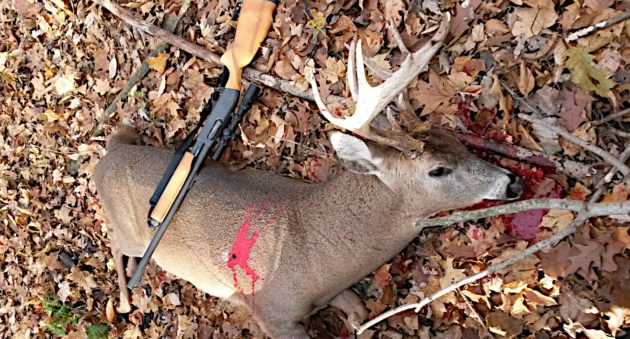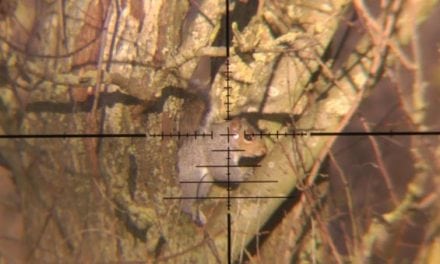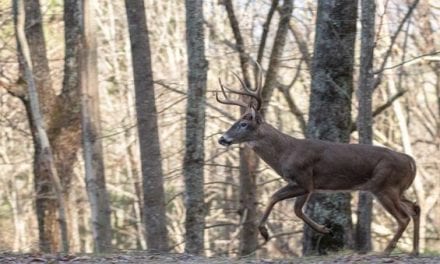
Here are our best deer tracking tips for a variety of scenarios.
So, you just made the shot on that mature buck you’ve been pursuing all season. Now what?
Well, the type of hit you made, and the type of weapon used should determine how you start tracking the animal.
Here we’ll go over several common blood tracking scenarios and what to do when you encounter them.
Because a different approach for each shot leads to a better chance of recovering the wounded animal.
Heart/Lung Shot
Personally, my favorite shot for whitetail deer is a lung shot, simply because it’s the largest vital area on a deer and provides the most margin for error.
I shot a 10-point on opening morning of firearms deer season six years ago that was still the best shot I’ve ever made on a deer. It was a perfect broadside shot from about 40 yards with my 12-gauge that took out both lungs. The buck didn’t even go 30 yards before collapsing from the shock of it.
No blood trailing required on that one. And more importantly, no suffering of the animal.
A heart or lung shot will often result in a short distance recovery with a rifle or shotgun. There are outliers of course. In 2004, I also made a lung shot on a 7-point with a muzzleloader at 100 yards. To this day, I’m not sure how, but that young buck somehow made it over 100 yards before dying. It’s different from deer to deer.
While most firearm shot deer will die within sight of you on a lung shot, it’s a different story with bowhunting. Most deer shot through the lungs with archery equipment won’t make it far, but in my experience, they tend to run a little further than a deer shot with a gun.
When you make a shot to either the heart or lungs, you’ll likely know right away. The deer will likely do a kick before taking off with its tail down. When you start blood trailing, it’s usually very easy. In the case of that 7-point I mentioned, it was like someone ran through the woods with a leaking bucket of paint. There was bright red blood splatter everywhere, and it was filled with tell-tale air bubbles. Near the end, I started finding frothy orange and white foam the wounded deer coughed up as it ran.
If you find blood sign like that, it’s usually safe to follow it up quickly. Odds are, that big buck isn’t going to make it very far!
Liver Shot
Funny enough, I have a real-world example of this from just this past week. Last Saturday my uncle shot a great-looking 9-pointer with his crossbow. The shot was just a few inches back from where he would have liked, and he suspected a liver hit.
A liver hit is almost always characterized with a darker, more watery blood trail. Sometimes it can be quite heavy to start, which has led to many hunters mistakenly believing the deer couldn’t have gotten far. That is, until they jump it and it takes them by surprise with no time for a follow-up shot.
Simply put, if you suspect a liver shot, you likely have a dead deer on your hands. But you need to back off. It’s probably going to take the animal a while to expire. In the case of the buck my uncle just shot, he backed off overnight. It was the right call. He found the deer the next morning not far from where he’d shot.
But one bad thing about liver shots is that they usually stop bleeding or only show sporadic blood after a while. Tracking deer like this can be difficult. My uncle had to expand the search beyond the last blood sign and just start walking trails because the blood ran out eventually. But it paid off in the end.
If you’re having a hard time locating your animal after giving it plenty of time to expire, you may need to call in professional deer trackers with dogs (if it’s legal in your state or province). Sometimes these dogs are the difference between a lost deer and venison in the freezer.
Gut Shot
I’ve seen a lot of disparaging remarks on the internet (especially in hunting videos) about hunters who gut shot a deer. First off, I just want to tell hunters out there that it’s okay. It can happen to anyone and I don’t think anyone tries to hit a deer in the guts; it just happens sometimes.
Maybe the deer was at a sharper angle from the treestand than you realized. Maybe an unseen tree limb deflected the arrow just enough. Maybe buck fever and the antlers got the best of you. That’s deer hunting. It happens. Don’t’ be ashamed of it. Instead, learn from it.
That being said, let’s talk about what to do when it does happen. You’ll probably notice if you hit a deer too far back and low. A deer hit in the guts will often hunch up immediately. Another tell-tale sign you’ve hit the guts are some ugly brown or yellow colors mixed with the blood. You may even find bits of undigested food that smells horrible. In that case, yeah, you probably have a gut shot.
The absolute best thing to do in this scenario is to back off. A deer shot in the stomach can run for miles if it is pursued right away. A gut shot can kill a deer, but you’re going to have to be patient. Six to eight hours is a good amount of time to wait before taking up the trail again. We’d only suggest going sooner if rain or snow is threatening to obliterate all signs of the trail. Even then, proceed with extreme caution.
Even if conditions are perfect, there are times gut shot sign runs out completely, especially for bowhunters when the deer decides to backtrack.
Before you go tromping through every bedding area and down every logging road looking for fresh tracks, it might be worth it to again consider calling in a tracking dog. Thankfully, these services are becoming more and more common throughout the country and they may be the difference between a recovery and a lost deer.
For more outdoor content from Travis Smola, be sure to follow him on Twitter and check out his Geocaching and Outdoors with Travis Youtube channels.
NEXT: HOW TO RUIN A DEER HUNTING SPOT
WATCH
The post Deer Tracking Tips for 3 Different Scenarios appeared first on Wide Open Spaces.















